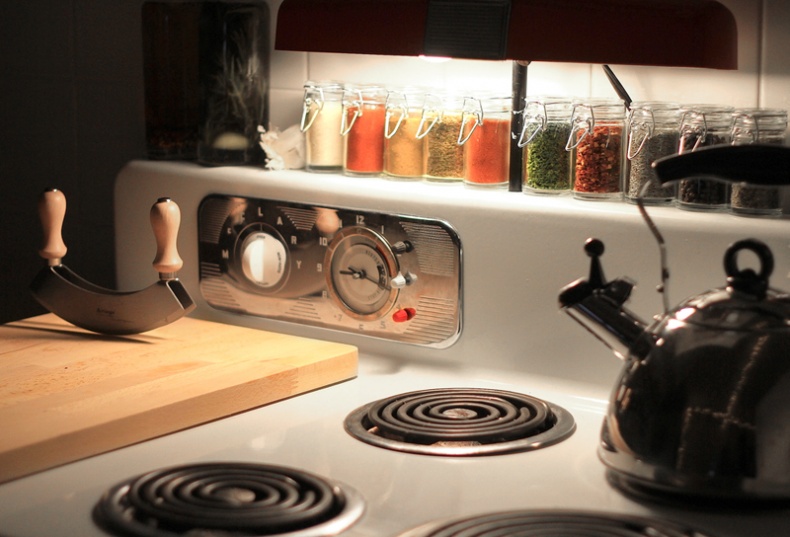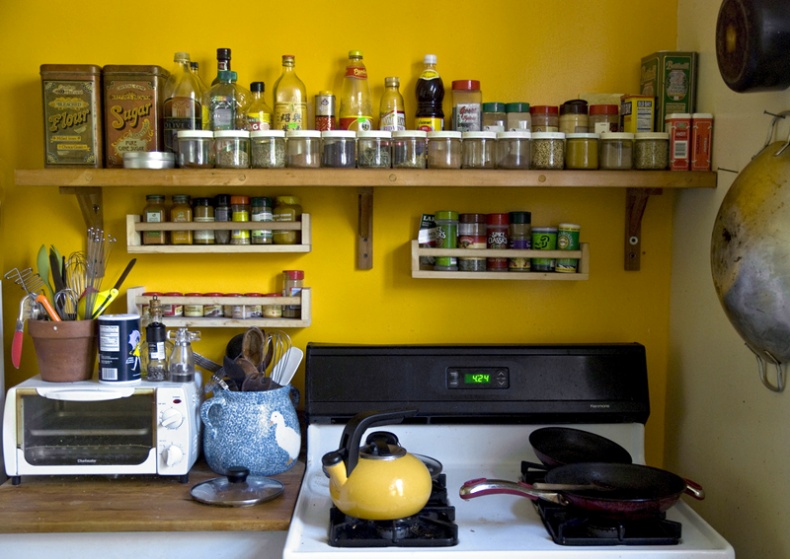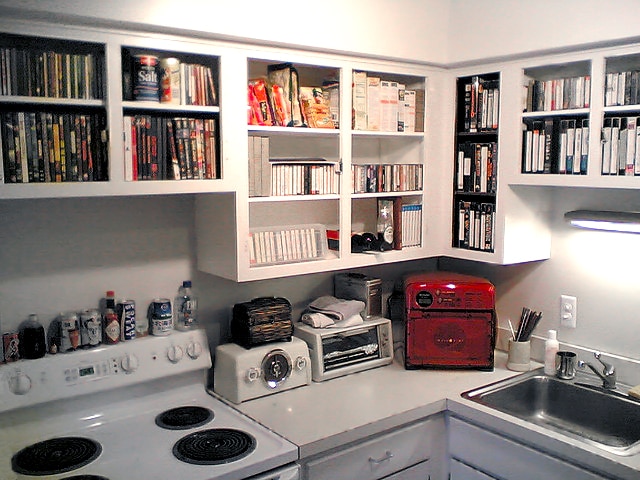
Kitchen by Rowena
Do you sometimes feel a bit lost in your own kitchen? Do all the tools that you need hide from you whenever you need them? Do you find it too dull but still have to spend loads of time there while preparing your food? Maybe it's high time for you to think about making little adjustments! After all, in most houses, the kitchen is the central area of the house, where every member of the family meets, and it would be a pity not to use its full potential. In this post, we propose a couple of simple and useful tips on how to make your cooking time more enjoyable.
Zoning Time!
We could generally agree that each kitchen has three different zones: a prep zone, where all the food preparation takes place (we spend about 70 per cent of our time in kitchen in this zone), a cooking zone for the actual cooking (10 per cent of our kitchen time), and a cleanup zone for doing all the boring washing up and cleaning afterwards (approximately remaining 20 per cent). Now the challenge is how to make the zones work for us in the best possible way.
1. Preparation Zone
Usually located nearby or next to the cooking zone, the preparation zone works at its best when it includes a sink, trash, and recycling bins at hand to all the chefs in the family during the preparation process. Food storage should be near the action, so try to keep it as close as possible to this zone. The same applies to the fridge, but here, more planning is needed, as the fridge serves both the people who cook and the ones searching for a late-night guilty pleasure, so it would be most convenient to keep it on the periphery of the kitchen and close to the prep zone at the same time.
2. Cooking Zone
The cooking zone can easily be the smallest, as it is probably the least used sector of the kitchen (you don't spend that much time stirring things or looking at them while in the oven). It generally works best if located next to the prep zone, with all its amenities. Spices should be within easy reach from here, as meals often need tiny adjustments at the last minute. Out of all kitchen zones, the cooking space should be the most protected — both in the sense of actual protection and in the sense of not being in the middle of home traffic. You probably don't need your children running around to get ice cream while you're lifting a pot full of boiling soup. And one more tip: don't forget to keep some "emergency space" next to the cooking zone in case you need to remove something from the stove very quickly.

Cooking zone by CRUSTINA
3. Cleanup Zone
It's advised to separate your cleanup zone from the other two zones in the kitchen. If you have enough space, it could be on the other side of the kitchen or a completely different location. As in most households, finding a second water source could be a problem, so make the cleanup zone adjacent to the preparation zone by using both sides of the sink for one or another zone. Of course the trash bin should be located nearby.
Generally, try to avoid too much zone-crossing, but it's understandable that some overlapping cannot be prevented. Before organizing the kitchen, have your usual workflow in mind and that will lead you to the best design results. For example, it's very common for people to follow this working pattern: fridge > prep zone > cooking zone > serving zone > cleanup zone. If this fits your needs as well, try to adjust your kitchen to these cooking dynamics.
Get Organized
If you're kitchen supplies are getting out of control and seems to live their own life in your overstuffed cupboards, try to organize them in a new way. First of all, ask yourself which stuff you really use and need at hand and what part of the supplies and equipment is just keeping up the space you could use much better. When you realize that you, will find out about many things to improve. Maybe the meat grinder doesn't need to be placed in front of the coffee machine you use every morning…
Secondly, think outside the box and maybe you will come up with new ideas and much more potential for storage space. What about keeping spices in drawers or buying little magnetic jars that can be stuck on the side of your fridge? Another classic trick is moving snacks, pasta, beans, and baking supplies into clear, wide-mouth jars and storage containers that are cheap and save up more space than most of us would expect. As you can see through them, restocking is done more naturally and there is a significantly lower number of unpleasant surprises occurring right when you need to use a specific ingredient. To keep the track of your ingredients (especially sugar and salt can be tricky), get stylish jar labels that you can either buy or design yourself.

Organized by Ramsey Beyer
If you're like most of us who aimlessly run around the house in search of a pencil and a piece of paper whenever we need to jot down a simple note, think of alternative solutions that could work perfectly in your kitchen. Magnetic boards, pocket folders, or chore charts and organizational boards could become a handy spot for your receipts, mail, or shopping lists. Here's a simple procedure that can inspire you to turn your kitchen wall into a chalkboard wall that will be loved by all the members of the household, spending only about $50. Get a writeable and erasable latex chalkboard paint at your local store (the usual choice is limited to green or black) and use a paintbrush to apply it on the wall. Two coats should do, and the second one can generally be applied just two hours after the first one. When finished, don't forget to make the wall become alive by using coloured chalks or attaching racks that can hold cooking equipment. After only couple of days with the chalkboard, you won't understand how your kitchen used to function without it!
Small Kitchens Rock
While many redesigning tips assume that your kitchen is full of space to be used up, we're very well aware of the fact that it's more of a dream than a reality to most of us. However, nobody says that small kitchens can't be turned into designer masterpieces. Here are some tips you might find useful if you're an owner of one of the not-so-huge kitchens.
Lack of storage space is often one of the main issues when it comes to trying to accommodate yourself in smaller kitchens. The solution could often be at hand. Look up! Try to maximize the potential of your walls. Hang everything that can be hung (install racks or be more creative and use for example good old pegboard that you will find in your parents' garage) and get as many shelves on the walls as possible. If you really feel that you need some extra space, don't hesitate to cross the borders and extend the kitchen cabinets to the dining or living room. It's not so difficult to do it in a way that won't disturb the spirit of another room, just make it look as pretty as possible.

Small kitchen by jm3 on Flickr
Once you've filled your walls and dining rooms up, you might find out that there's actually more space than you need, however unlikely that sounds. Now here's another tip: if possible, exchange one of the closets for a tiny sitting space, preferably by the window. It will add a cozy touch to your kitchen and the dry, utilitarian room will suddenly transform into a nice space to spend your time in, even if you're not in the process of food preparation. If you don't like the sitting space idea but still feel that you need to spice up the kitchen area, consider creating or buying an island. An island can serve as a table, bar, counter workspace, and extra storage space at the same time while being perfectly movable and modular to fit your needs. The only trouble with islands is that they usually cannot fit within the really small kitchens, but maybe you can still use it in the dining room.
One last piece of advice: don't be afraid of the curtains. Even though curtain walls somehow carry a stigma of lousy apartments, don't follow the prejudice. Curtains with beautiful patterns and colours can brighten up your home and save space as well as organize different rooms. If your kitchen seems to be just an extension of another room, a curtain that partly covers the kitchen area but still leaves enough space for the light to get in could be the perfect solution for you.
Do you have any other kitchen design tips you would like to share with us? Please, let us know about some of your top tricks!





